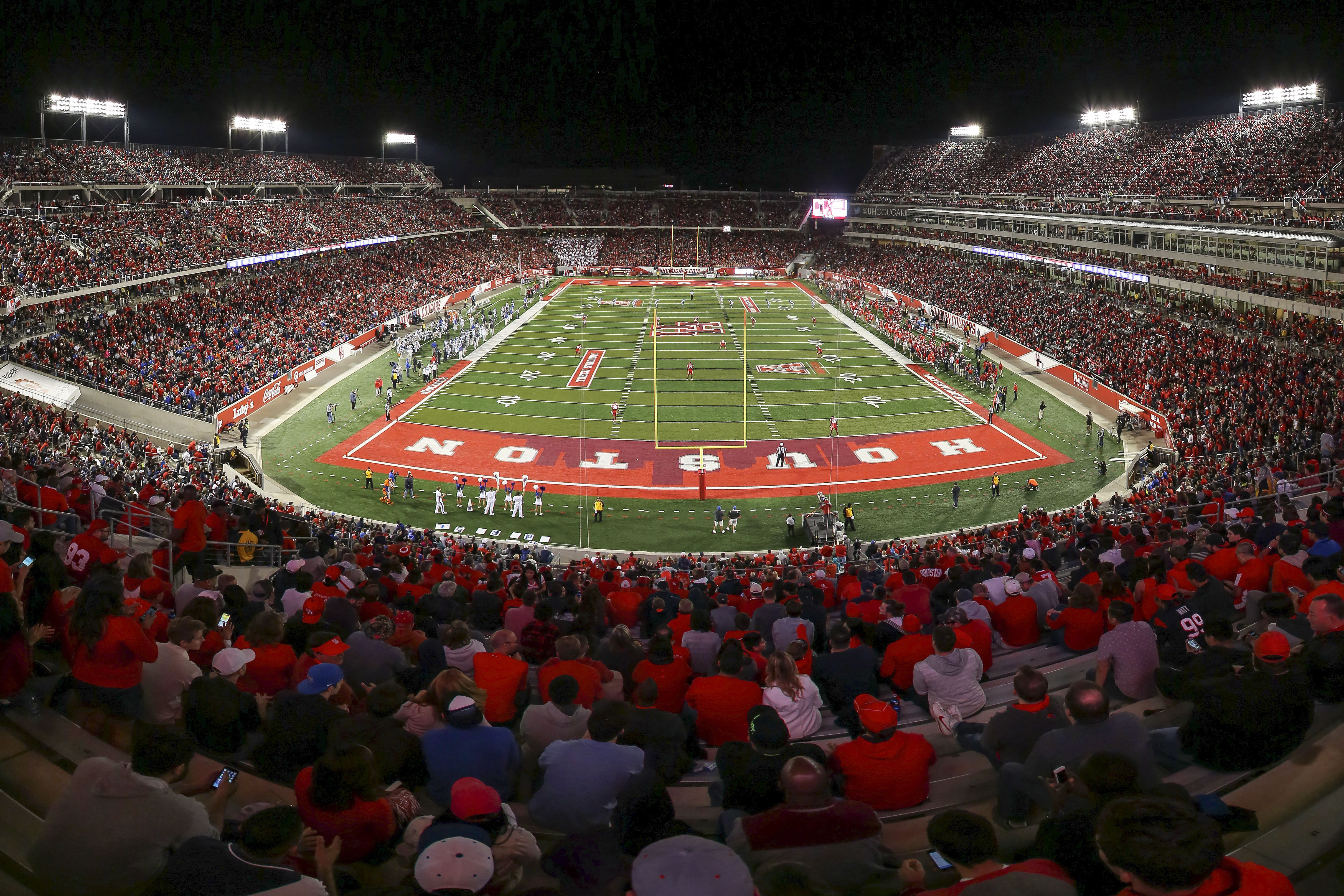
As UH Football Mania Mounts, Can the Squad Live Up to the Hype?
Spring football workouts at the University of Houston are held in April, before the semester ends and the summer humidity sets in. If you’re not a traditionalist who believes the sport is better suited for the snow or mud, playing conditions are practically perfect. Kanye West and Future records thump through four club-sized speakers, while cameras on cranes tape every movement from every conceivable angle. The sidelines are peppered with local high school coaches, burly men in sweat-stained visors trying to glean a few tips from second-year head coach Tom Herman—described, by various Texas football insiders, as a “quarterback guru,” “offensive whiz kid” and “genius.”
His team practices on a pair of unremarkable fields, one turf and one natural grass, that sit side-by-side along Scott Street, in the Third Ward. Players can see the downtown skyline in the distance, but a padded green wall, maybe eight feet tall, separates the athletic facility from the adjacent METRORail track and the city beyond. During training camps, Herman—generally open and candid—doesn’t mind the temporary privacy.
After the players do some light stretching, the 41-year-old hisses into his whistle. Several dozen Cougars hustle over, forming a circle in between the hash marks. The coach signals for two players to meet in the center. While their teammates whoop and holler, the combatants, one from the offense and one from the defense, settle into three-point stances. On Herman’s command, they leap forward and crack into each other, driving their legs, grinding their red helmets, trying desperately to wrestle each other to the ground.
It’s the most elemental of drills, meant to instill toughness and underscore the importance of effort, of heart. The testosterone flows. When the first player finally hits the deck, Herman smirks and points to the victor like a sadistic boxing referee. He might look like a golfer, but the former wide receiver has never been one to shy away from contact. (“I miss hitting people, for sure!” he says.) A few seconds later, Herman pulls in two more guys, crouches down, and watches the violent spectacle all over again.
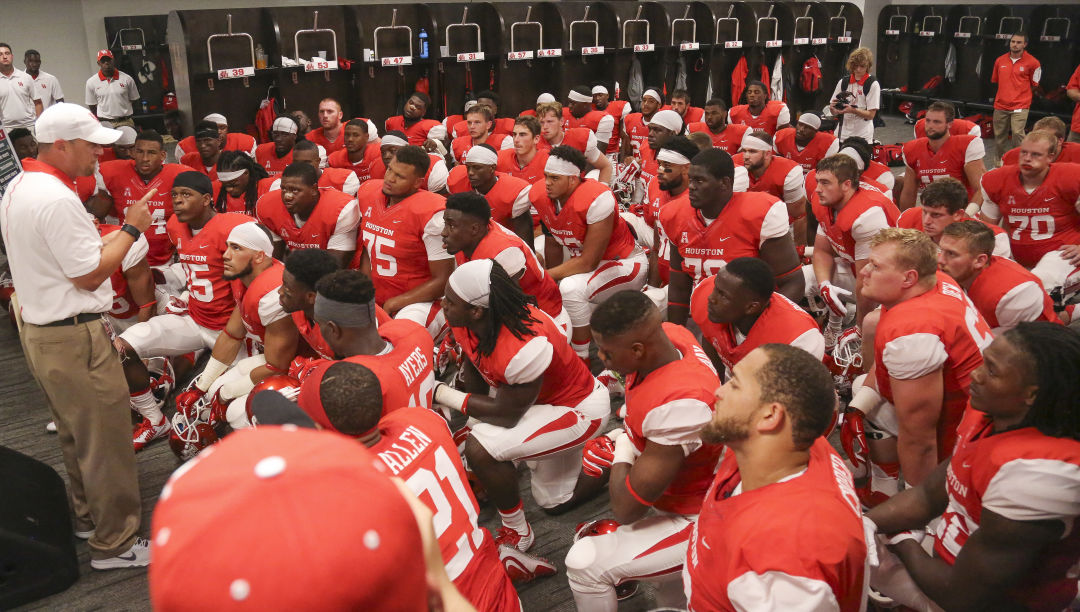
Coach Herman's magnetism inspires loyalty in young players who are required to do painful things.
Image: Jessica Villarreal-Almanza
Herman lacks patience. He’s aware the Cougars’ 2016 campaign won’t actually kick off for another 22 weeks. “I need to be reminded of that fact by our coaches quite often,” he says, “that we don’t play tomorrow.” On the other hand, he can already sense the enormous expectations his players now carry. In Herman’s first year on the job, UH finished 13-1, beating three top-25 opponents and then powerhouse Florida State in the prestigious Peach Bowl. The Associated Press ranked Houston eighth in its final poll, the school’s highest result in 36 years. Season ticket sales are surging, merchandise flying off the racks.
For their 2016 opener, on September 3 at NRG Stadium, the Cougars will host the University of Oklahoma, a perennial national-title contender. It’s a huge showcase, maybe the most important regular-season game in program history, one that could serve as a springboard to another conference championship, Heisman Trophy consideration for quarterback Greg Ward, Jr., and, if the stars align, a berth in the four-team College Football Playoff. (UH would be the first school outside the “Power 5” conferences to qualify.) At the very least, the nationally televised broadcast presents another opportunity for UH to demonstrate exactly why Houstonians of all stripes, and not just alums, have reason to embrace the Cougars as one of their own.
So yes, it’s a long way from April to September. But it’s not that far off, either.
When the gladiator routine runs its course, Herman takes a minute to address his team. Pacing around the 30-yard line, he tries to stress how much preparation is required to succeed against the country’s best. There’s a frenzied look in his eyes.
“There’s no such thing as just a day at the University of Houston football program. Just another day doesn’t exist. It’s fourth and f****** inches, every snap of every f****** period, every time! EVERY TIME!”
He takes a breath, regroups.
“I want to see 85 guys stick their foot in the ground and go, full-speed. That’s what I want to see. We haven’t had it yet, but I want to see it today. We good?”
His roster answers affirmatively, in unison. Then an air horn blows, and the young men scatter in various directions, readying themselves for more character-building brutality.
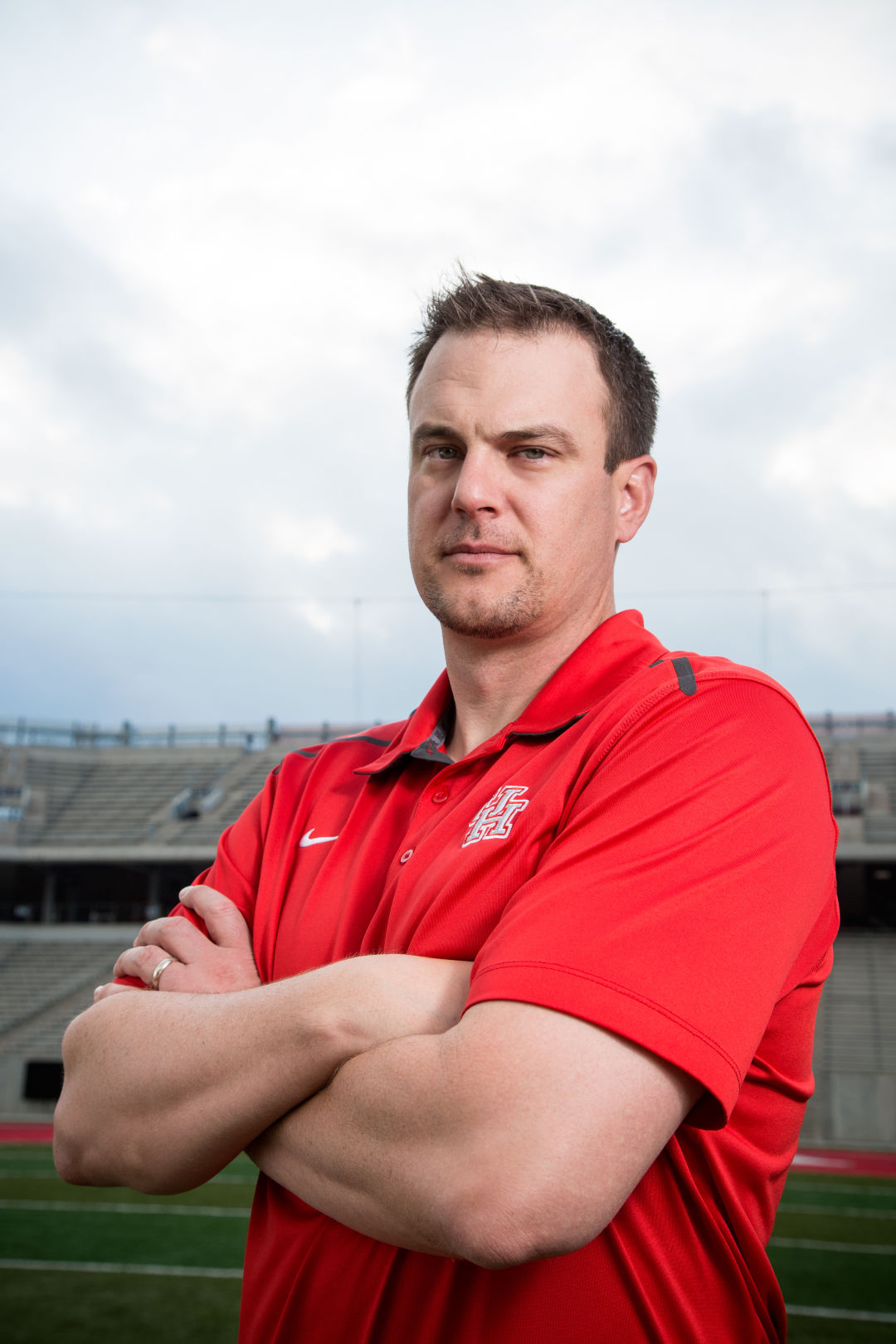
Image: Jessica Villarreal-Almanza
Tom Herman was an only child, energetic and curious. Raised by a single mom in Simi Valley, California, he played the trombone, ran for student government, and always asked “why, for everything.” He was also extraordinarily competitive. “I don’t like to lose, man. At anything,” he says. “I wanted to be first in my class, I wanted to beat my grandmother in tiddlywinks.”
Playing baseball, basketball and football, he found an outlet for that aggression, along with the male camaraderie he lacked at home. His teammates were his brothers, his coaches his mentors. At California Lutheran University outside Los Angeles, Herman lettered in football; he was fearless but limited athletically and prone to injury. “He was definitely mentally smarter than maybe he was physically gifted,” says Bryan Marmion, one of his coaches. “He wanted to understand concepts, not just assignments. It wasn’t enough to know, ‘Hey, run this route.’ It was, ‘What are we trying to do here?’”
A few months after graduating cum laude, in 1997, Herman sent letters and resumes to every Division I school in America, pleading for work. Nobody responded. So Marmion, who’d recently taken over at tiny Texas Lutheran, in Seguin, hired the scrawny twenty-something part-time, for a $5,000 stipend and a dining hall meal card. Herman crammed his belongings into a Honda Civic and moved to Texas, sight unseen. On the dusty drive east, the Californian was certain he’d spot cowboys crossing I-10 on horseback: “My very first impression was, ‘Oh my god, what did I do?’”
Marmion could sense Herman’s potential right away: the work ethic and drive, the interpersonal skills. Herman was never afraid to get his hands dirty, be it chalking fields or washing uniforms. He was savvy, too. Austin was only 50 miles up the road, and he’d visit the University of Texas in his spare time to observe practices and mingle with Longhorn staffers. The big boys up north liked his chutzpah; the following fall, UT offered him a coveted graduate-assistant position.
Ambitious coaches lead peripatetic lives. It’s impossible to predict when and where a more promising opportunity will pop up. After two years in Austin, Herman landed a full-time gig at Sam Houston State. Four years later, Texas State brought him on as its offensive coordinator. Stints at Rice (2007–2008) and Iowa State (2009–2011) followed. Each provided a larger stage, with more responsibility and more talented athletes to direct.
Barrick Nealy, a quarterback who set school records under Herman at Texas State, thinks his old coach is especially skilled at maximizing the potential of his players. “No one studies film the way he does, the way he breaks it down and simplifies things,” Nealy says. “You always know where to go with the ball. He does a lot of the thinking for you.”
In 2011, Ohio State head coach Urban Meyer dialed up Herman for an interview. They’d never even met. “Tom wasn’t the biggest name out there,” Meyer writes in his book, Above the Line, “and if the media and OSU fans knew about the people who wanted the job, they probably would’ve told me I’d lost my mind.” Meyer named Herman his offensive coordinator anyway, and the duo—running power-spread schemes that Herman had perfected along his circuitous career path—won 38 of 41 games over the next three seasons, capping off their partnership with a 2014 national title.
The very next morning, confetti still dotting AT&T Stadium in Arlington, Herman jumped into a rental car and sped south to Houston. He had work to do.
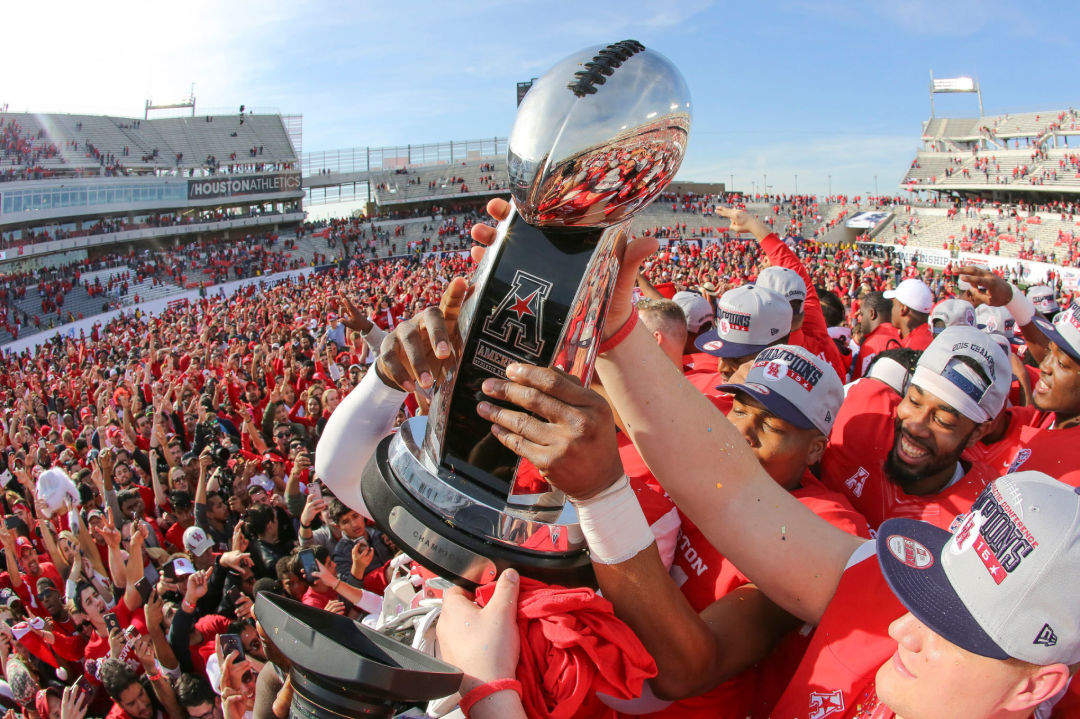
Last year, the Cougars beat powerhouse Florida State in the prestigious Peach Bowl.
Image: Jessica Villarreal-Almanza
UH football is, in some ways, a victim of NCAA realignment. When the Southwest Conference dissolved in the mid-1990s, many of its pigskin-mad members (UT, Texas A&M, Texas Tech) were absorbed into the Big 12, a new conference that promised increased exposure and additional television revenue. In the Southwest, the Cougars were generally competitive, “maintaining that status right below the really big state schools,” according to Greg Tepper, managing editor of Dave Campbell’s Texas Football.
At its new home in the nascent Conference USA, which they joined in 1996, Houston was an afterthought. Attendance, never sterling to begin with, cratered. Infrastructural investments lagged. Even when UH put together compelling seasons (2006, 2011), or moved into a more respected league (the American Athletic Conference, 2013), Houstonians largely ignored the team. The city prioritizes its professional sports franchises, and the Cougars never won consistently enough for people to care.
UH athletic director Hunter Yurachek likens a college football program to a front porch. “It is not the most important room in your house,” he says, “but it’s the most visible room in your house.” Dr. Renu Khator, appointed Houston’s president in 2008, understood this. Quickly, she set about polishing the school’s curb appeal. Her administration issued revenue bonds and solicited donations to build TDECU Stadium, a shiny 40,000-seater, for $128 million (and counting). Financial data acquired by the Texas Tribune shows that UH officials transferred more than $100 million from its academic budget into its athletic department between 2008 and 2014, money used to cover operational expenses.
Critics might question why a college would redirect scarce resources into its sporting coffers at a time when tuition is ballooning and knowledge about traumatic brain injuries in football spreading. But these decisions are part and parcel with Khator’s efforts to establish UH as a “tier one” research university and ditch its identity as a commuter school. Better facilities and uniforms, the theory goes, help draw better players. Better players win more ballgames. Schools that win more ballgames attract more applicants and generous alumni gifts. The whole pie gets bigger and tastier.
Khator also spent a small fortune to lure Tom Herman away from Ohio State—his contract, at $2.8 million per year, runs through 2020. It’s an investment Cougar backers feel has already paid significant dividends.
In the Third Ward, Herman’s reputation didn’t necessarily precede him. Junior wide receiver Steven Dunbar remembers that he “actually didn’t know much about him before he took the job.” “Nothing at all,” says Cameron Malveaux, a senior defensive end. “Like not one single thing about him.”
The new hire made his expectations clear right away, chaining the locker room shut during his first week on campus because team members were tardy and messy. Later in the summer, Herman warned that his preseason training camp would be “the hardest training camp in college football history.” “The dude seemed like a dictator at first,” Malveaux says. “That’s just because he was trying to show us that he wasn’t playing around, and that we should take him seriously. And I’m glad that he did.”
Herman’s alpha-male excess is balanced with heavy doses of compassion and humor. When he sees something he likes on the practice field, he will drop his clipboard and sprint 40 yards to deliver a ferocious high-five. Kisses on the cheek or the forehead are now fully normalized within the UH culture; it’s a byproduct of Herman’s Italian roots, as well as his impression that “in this uber-macho college football machine … we’ve lost the intimacy of the coach-player relationship.” (Mason Denley, a sophomore offensive lineman, considers his first Herman peck “the scruffiest kiss I ever got.”)
The coach’s relative youth is an asset, too. It’s easier to relate to the adult in the headset if he also shops for custom grills with Paul Wall and wears a T-shirt printed with O.T. Genasis lyrics (“I Got Baking Soda”) over his employer-issued polo. That magnetism inspires loyalty from 19- and 20-year-olds who are required to do painful things.
“He’s shown the players he’s all in. And no matter what he’s asked of them, he’s every bit as committed to their success as he’s asking them to be,” says Marmion, Herman’s one-time boss. “And kids see that, and they know when it’s real, and they know when it’s just a stunt.”
Those close to the program all point to the second game of the 2015 season, a sunny September Saturday at Louisville, as the Cougars’ breakthrough. Ward, the quarterback, threw two of his three touchdown passes in a wild, seesaw fourth quarter, including a 15-yard game-winner with 3:09 on the clock, and Houston’s special teams unit partially blocked a late field goal attempt by the Cardinals to secure a 34-31 win. “We had our 70-year-old trainer in there dancing around, singing, waving a flag,” Yurachek remembers.
From there, UH ripped off wins in 11 of its last 12 games, losing only a squeaker to Connecticut while Ward was sidelined with an ankle injury. They played at a frenetic speed (95th percentile in adjusted pace), they dominated field position (17th nationally in field position margin), they stuffed the run (fifth in rushing yards allowed), and they showed mettle in tight contests (3-1 in one-possession games). When the offense was really cooking, scoring drives felt inevitable. Navy head coach Ken Niumatalolo, an AAC rival, minces no words: “They are as good a football team as we’ve played since I’ve been here.”
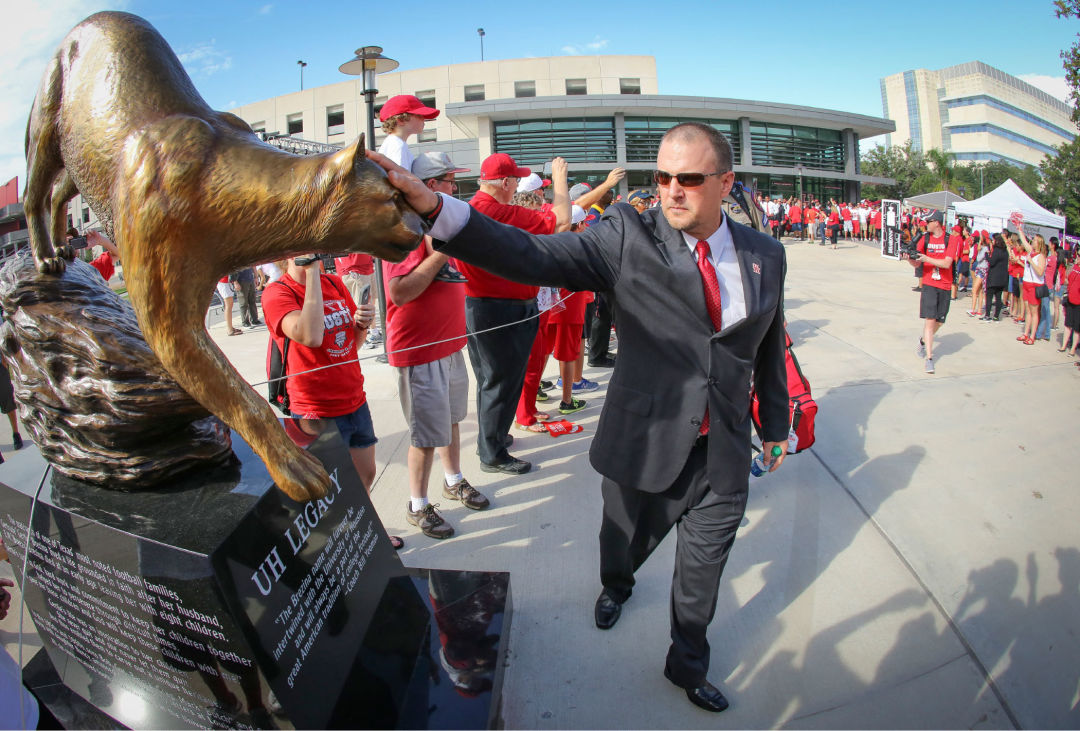
Some fear the coach will jump ship for a school like UT.
Image: Jessica Villarreal-Almanza
Football can’t be played at half-speed, which complicates the ritual of the spring game. Ostensibly, it’s the last chance to scrimmage before summer vacation. Coaches want to see effort, but not so much that a player injures himself. And so schools like UH fire up the scoreboard on a random Saturday each April and host what amounts to a high-speed dress rehearsal, with their team’s returning underclassmen in the lead roles.
At TDECU Stadium, the tailgaters and red-clad boosters have all come to see Greg Ward, Jr. And why wouldn’t they? Even his own teammates occasionally gape. “I find myself watching him, trying to block for him, just watching him go,” says Dunbar. “I’ll tell my kids about it.”
For a quarterback, and just in general, Ward is small. He grew up in Tyler, a baby-faced three-sport stud who was raised to let his actions speak for him. (Because the new face of UH football is so shy, part of his offseason training actually involves lessons with a PR professional.) He played receiver for the first 18 months on campus, before the previous coaching regime realized it would be useful to have their most dynamic athlete touch the ball every down. In 2015, Ward’s first full season as QB1, he rushed for 21 touchdowns and threw 17 more. Miss an assignment, or hesitate even for a blink, and the uber-quick five-foot-eleven senior pounces.
Ward is by no means the sole reason UH will be ranked among the top 25 programs and favored to win the conference title come September. From last year’s squad, the Cougars return 12 starters. In the backfield, they’ll integrate tailback Duke Catalon, a UT transfer and former four-star recruit who Herman calls “the real deal.”
Across the line, freshman Ed Oliver will anchor a potentially dominant front seven. A product of Westfield High in Spring, Oliver is an anomaly, a physical freak and the first five-star recruit in college football history to shun the likes of Alabama and LSU for a non-Power 5 school. He wanted to play with his brother, a Cougar offensive lineman, and he bought into the vision Herman laid out—that of an “H-Town Takeover,” a soon-to-be national juggernaut built sustainably with homebred talent.
In their first full recruiting cycle, Herman and his nine carefully appointed assistants signed 24 players, 12 of whom hail from Houston and its suburbs. No surprise—the staff shares 156 combined years of recruiting experience in the state of Texas. “There are some guys on his staff who have unbelievable connectivity to the greater Houston area,” says Tim Teykl, past president of the Greater Houston Football Coaches Association. “That’s just an instantaneous red carpet, walking into a field house, when you have those roots.”
The region is fertile, in other words, and talents like Oliver represent the cream of that desirable crop. For Herman, they’re now attainable. “The phrase we like to use around here is ‘seal the boards,’” says Tepper, of Dave Campbell’s Texas Football. “If you can just get the best players in Houston, every year? You’re going to be a pretty darn good team.”
The spring scrimmage did offer a few morsels to savor, like the 90-yard bomb that Ward dropped on the button to a streaking Isaiah Johnson, a receiver who subsequently smoked four UH students in a promotional race at halftime. As the Cougar faithful filed out of TDECU, Herman addressed the expectant scrum of beat reporters. A few poorly executed plays bugged him, but he felt optimistic overall: “That’s the name of the game—run as fast as you can and hit somebody as violently as you can when you get there. And we do that as good as any team I’ve been around.”
The Jumbotron overhead flashes a gaudy score of 74-72, White over Red. But few in the stands or the press box can actually determine how Herman’s staff has been awarding points. Earlier in the afternoon, a season-ticket holder who’d buttonholed Herman in the stadium corridor couldn’t pass up a chance to make an obvious intrasquad joke: “I hope y’all win today!” Herman hiked up his cargo shorts and shot her a wry smile. “I’ve got a feeling we will.”
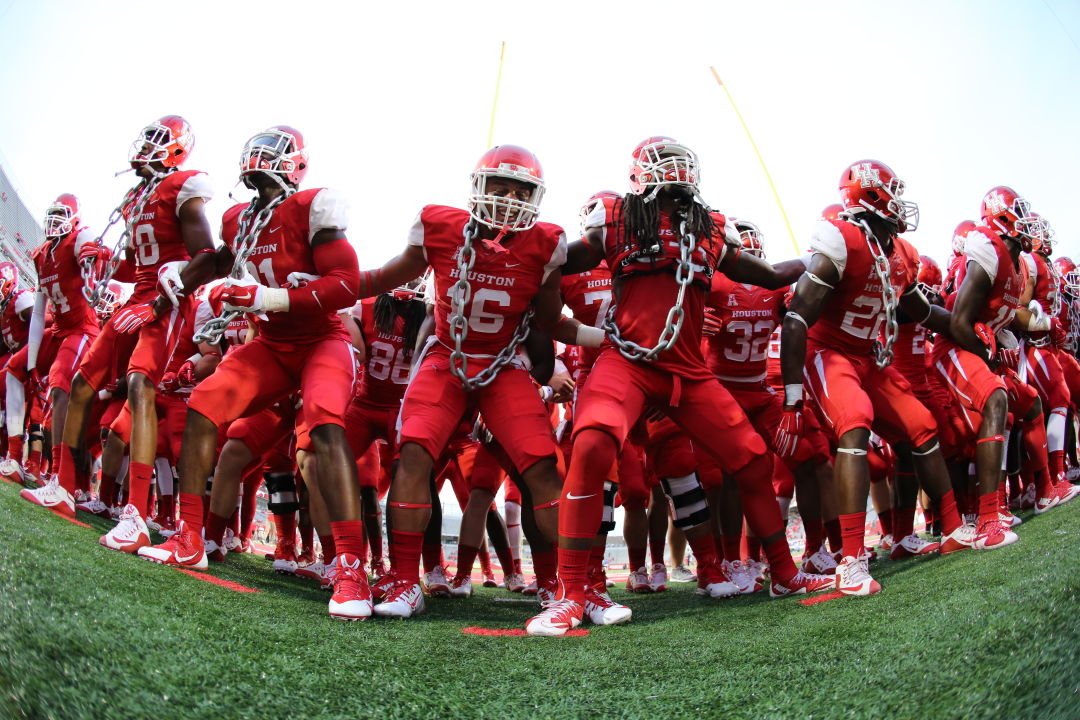
Players take part in the newest pregame tradition involving chains and using a "family" philosophy to play for the student body.
Image: Jessica Villarreal-Almanza
Six weeks later, Herman walks into a Tanglewood banquet hall dressed sharply, UH pin affixed to a crisp blue sport coat. About 75 alums of the Valenti School of Communications have paid $100 a head to watch “an intimate, exclusive” conversation between Fox 26 sports director Mark Berman and their hot-shot coach. When Herman enters, the attendees crane their necks and stare, starry-eyed, briefly ignoring the circulating beef crostinis.
The energy in the room is palpable, in line with the Cougars’ growing commitment to the gridiron. These diehards know a $1 million locker room renovation is already underway, and that a $27 million indoor practice facility and weight room will soon follow. They know the Big 12 is set to expand, and that Khator and her deputies are lobbying hard for an invitation, one that would instantly boost UH’s credibility—not to mention its media rights, by eight figures annually. And they know Herman has inked, in his first try, the most talented recruiting class in school history. When he speaks about tough love and the momentum his staff is generating, middle-aged business-types nod vigorously, like church congregants during a moving homily.
Still, there’s anxiety hanging in the air. Given all the fumbles they recovered and tight games they survived, UH overachieved last year, honest fans will admit. And the schedule this fall is unforgiving, with the world-beaters from Oklahoma visiting Week One and several tricky road games (Cincinnati, Memphis, Navy) in conference play. Then there’s the unverified though oft-rumored possibility that Herman will jump ship for a blue blood like UT, sinking the H-Town Takeover before it truly has a chance to take off.
Berman opens up the floor for questions. Real estate developer and UH alum Welcome Wilson grabs the mic first. A few hours prior, Baylor fired its own head coach, Art Briles, creating a high-profile vacancy in Waco. Wilson wastes no time.
“Tom, have you heard from Baylor University today?”
Herman shakes his head, anticipating the cordial interrogation. “I have not! And I can say that with all honesty.”













































